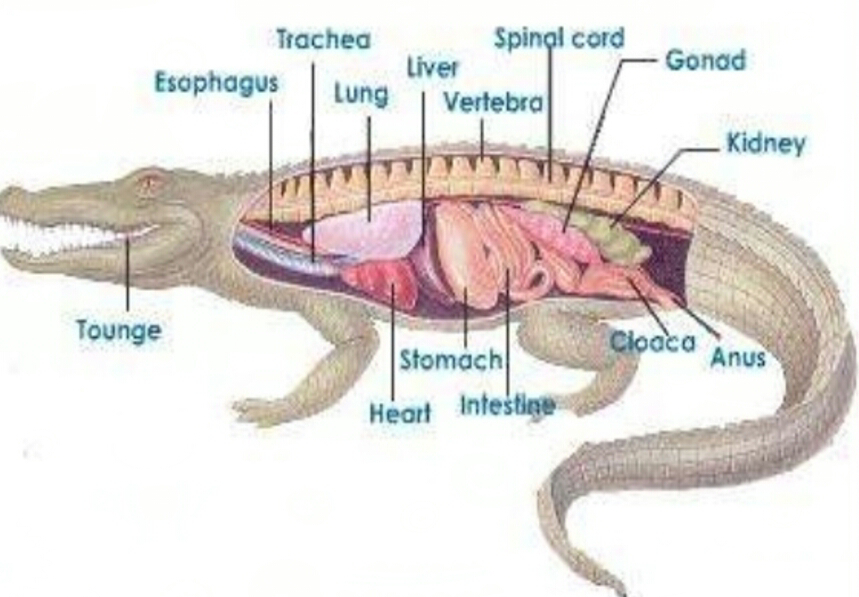What are Reptiles?
- An animal that crawls or moves on its belly.
- On small short legs
- Cold-blooded, air-breathing
- Body typically covered with scales
- They are distinguished by having a dry scaly skin
- Typically laying soft-shelled eggs on land.
- approximately 7,900 species
- habitats includes deserts,forest,freshwater wetlands,mangroves and open oceans.
Characteristics of a Reptile
- many are egg-bearing
- some bear live young
- breath through lungs, they normally have two lungs
- row of identical teeth
- dry, scaly, impermeable skin(keratin)
- most carnivorous (insectivorous)
Reptiles Integument System
- Reptiles have thick and protective skin
- Their scales are made of keratin
- Reptiles have few specified glands. The ones they have usually secrete pheromones.
Reptile Digestive System
1. The digestive system of a reptile depends on what kind of food they eat.
2. Meat eaters have very simple stomach and short intestine.
3. Plant eaters have more complicated stomach and long intestine.
4. Some have large stomach because they have t chew the flesh they eat in two small pieces.
Circulatory System
✴The circulatory system of a reptile is composed of two loops:
☞The pulmonary loop carries deoxygenated blood from the heart to the lungs and returns oxygenated blood to the heart.
☞The systematic loop transports oxygenated blood to the tissues of the body and returns deoxygenated blood to the heart.
☞Deoxygenated and oxygenated blood are kept separates during contraction of the heart by the actions of the heart valves and the movement of the septum and ventricular walls.
☞It is advantage for a reptile to divert blood away from the lungs to conserve energy.
▶For example, an inactive reptile needs so little oxygen that it may go a long time without breathing.
☞Similarly, aquatic reptiles do not breathe while they are underwater.
☞Under these condition, the heart pumps blood to the body while reducing circulation through the lungs.
Kingdom: Animalia
Phylum: Chordata
Class: Reptilia
Order: Squamala
Order: Testudinata
Order: Crocodilia
Order: Rhynchoceplaia
✔Suborder: Serpent or Snake
🔘2,125 species
🔘 no limbs
🔘no external ear openings or eyelids
🔘 ribs extended the entire lenght of the 🔘vertebral column.
🔘 all are carnivorous
🔘Some snakes have an “extra” pair of eye (more correctly sensory organs) locatedon the fore head that can detect infrared radiation.
🔘They can “see” the heat of a mouse from a meter away, even in conditions where our eyes would see only pitch dark.
✔Suborder: Lacertilia- Lizards
🔘5,000 different species
🔘Due to their extremly tunes eyesight, many species of lizards have higly acute color vision.
🔘Most species of lizards are harmless to humans with the exception of the komodo dragon,which is the largest species of lizard in the world.
🔘Some species of lizard can shed their tails when they are in danger, but not all species of lizard are capable of doing this.
🔘all oviparous with no parental care
some live over 100 years
🔘weigh over 600 lbs-
🔘240 species in the world
🔘males are smaller than temales
🔘females platron convex, male's concave
🔘males have longer claws
2. ALLIGATORINAE- alligators and caimens:snout are more blunt.
3. GAVIALINAE- gavial or gharial snout beak-like
🔘Only one species of Gavial:
Gavialis gangeticus
ANATOMY OF A CROCODILE
📌small to medium sized reptile
📌lizard-like appearance
📌generally green or brown in color and can grow up to a neter in lenght
📌Long lived: 60-100 years or more
📌Adults live in ubderground burrows and are nocturnal.
📌known to eat their offspring
📌Carnivorous
📌the tuatara only mates every 4-5 years and lack of copulatory organ-mate by repressing the cloaca
📌the famales lays about a dozen
leathery eggs which she digs into the ground
📌the eggs of the tuatara often take more than a year to hatch

















No comments:
Post a Comment